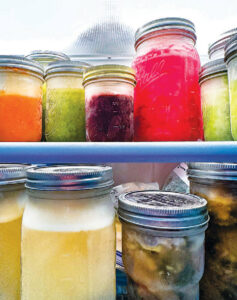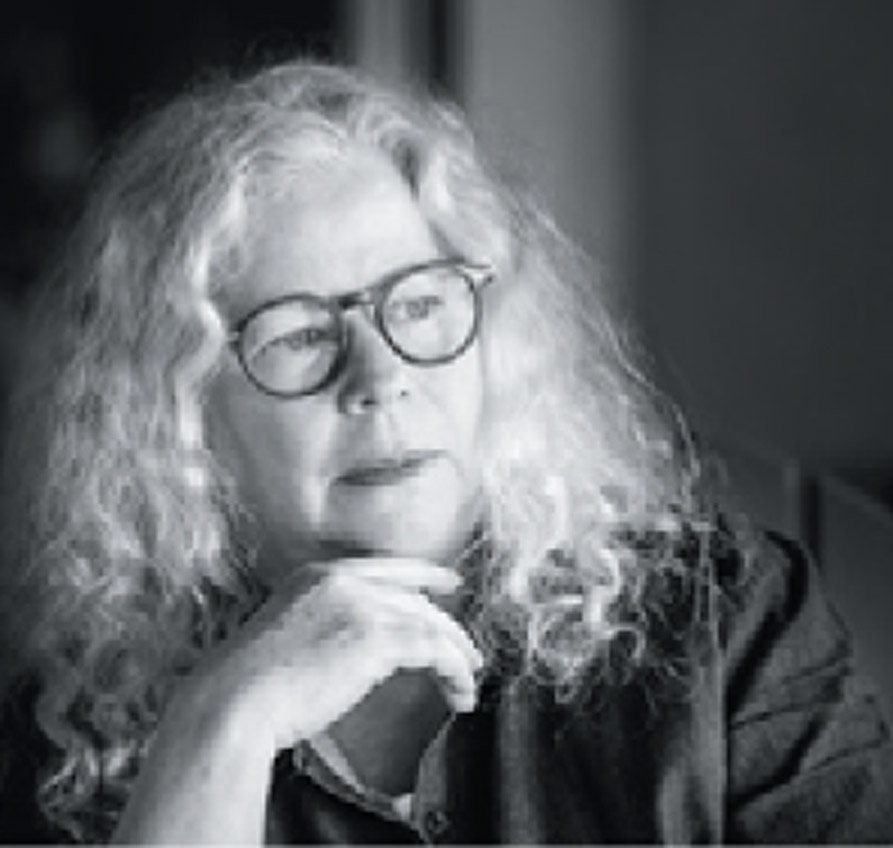WORDS AND PHOTO BY MARIA RODALE
I LOVE MY FREEZER.
Well, true confession: I have two of them.
Why would anyone need two freezers? Because it’s the best way to store the bounty of summer and preserve local organic foods in their prime season. I’ve got jars of preserved sour cherries from my own tree, black raspberries from my bushes, tomato sauce, pesto, vegetable soups, applesauce, and healing homemade chicken broths. Those are just the jars. Then in freezer bags, I have blanched green beans, chickpeas, raw poblano peppers, and tomatoes. Suffice to say, I make the most of my freezer(s).
I also have lots of single-serving leftovers. Now that I live mostly alone, once I make a pot of soup or chili, I freeze the extra in single-serving containers. Basically, I have my own TV dinners, cooked exactly to my specifications (no sugar, no chemicals, all organic, low salt).
Here’s how I make it work for me: The main freezer is what I use on an everyday basis. The one in my garage is home to everything else, stored for the long haul. It has cuts of the organic whole pig I buy every year from the Rodale Institute, which I share with my family. It also has all the other things that don’t fit in the main freezer in my kitchen. That freezer gets me through the winter (and is the main reason I have a backup generator for my house—the freezer and coffee).
Here are five ways to make the most of your freezer, no matter how big or small:

Why would anyone need two freezers? Because it’s the best way to store the bounty of summer and preserve local organic foods in their prime season.
FREEZE THINGS WHEN THEY ARE IN SEASON AND AT THEIR RIPEST.
Some things do best when cooked quickly (blanched). Others don’t. If you want to freeze raw berries, for instance, put them on a baking tray in your freezer and let them freeze before you toss them in a bag. Or you can cook them in a bit of water and then you have a nice sauce to add to yogurt. But only freeze the absolute best and healthiest fruits and vegetables. If there is a rotten spot, cut it off or compost it.
Favorite use: By the end of summer the freezer must hold my very green pesto, along with tomato sauce and applesauce. Otherwise, I feel very unprepared for winter.
FREEZE THINGS IN THE SIZES YOU WANT TO EAT THEM.
Small jars or bags are great for single servings. Large jars are best for bigger meals. Some people freeze things in ice cube trays as well. One big pot of soup can turn into four or five individual lunches. When you pop the lid off and microwave to thaw, it turns into a warm and yummy wholesome lunch or dinner for one in just five minutes. I drink it or eat it right from the jar!
Favorite use: Homemade chicken broths in both large and single servings create my own healing apothecary.
FREEZE YOUR LEFTOVERS.
For the past few years, I’ve made Thanksgiving or Christmas “platters” on glass pie plates that have all the good things—turkey, stuffing, gravy, mashed potatoes, yams, etc. I cover each pie plate with plastic wrap to keep the air out and then either foil or another plastic bag and voila! There is a full, delicious meal when I need it most (microwave it for as long as it takes to heat).
Favorite use: I freeze bananas that are ripe but probably won’t be eaten. They get frozen on a baking tray first, then I throw them in a plastic bag. Afterward, I make them into the most delicious sugarless soft chocolate ice cream! Add them to a food processor with a liquid of choice—either plant-based milk or cream. Then toss in some pure cocoa powder and blend until it’s the smooth texture of soft ice cream. There are so many variations to this I can’t even …
LABEL EVERYTHING AND DATE IT.
For me, Sharpies are indispensable. Others prefer fancy labels. But don’t think you’ll remember what is in a jar or bag and when you froze it. Trust me on this. Some things look quite similar once they are frozen in a jar. I use the month and year for dating. And my general rule is if it’s over a year old, it’s probably better to put it on the compost pile. Of course, if it smells bad don’t eat it. Sometimes, if I am in the mood, I’ll get creative with the labeling. That’s fun when it’s the middle of winter and you pull out a container of “end-of-summer vegetable soup.”
Favorite use: Sometimes I name my frozen items after the hurricanes I cook them during, or on special days. I smile when I thaw them out.
EXPERIMENT!
What’s the worst that can happen? Well, the absolute worst? That’s when you have a freezer full of food, the power goes out, and everything thaws and you lose it. Sure, your homeowner’s insurance may reimburse you, but it’s heartbreaking to lose that food.
Once, I went away for a weekend and accidentally didn’t close the freezer door all the way because something was stuck. Fortunately, it was almost summer, and I had already eaten almost everything in it. You will know if something turns bad by how it looks (freezer burn, for example) or smells. If I have a big piece of meat with freezer burn, I will cut off the bad parts and still cook the good part. (This is especially true if it’s something precious, like venison.) But for the most part, you can try almost anything and if it doesn’t work, toss it on the compost pile.
This past summer I had an obscene amount of zucchini from just three seeds I planted. I tried multiple ways of freezing them—from my favorite, Zucchini Slice (an Aussie breakfast egg bake) to Asian Pancakes, boats for stuffing, slices for lasagna, and who knows what else I packed into my freezer. By spring, I will know what worked and what didn’t.
And I also know now that next year I’m not planting more than two seeds.
But here’s the thing: You don’t need a big freezer, or an extra freezer in your garage or basement, to make the most of the freezer you already have. Start small and just freeze things like pesto, extra fruit, or your leftovers. Try things. And see where it takes you. Through trial and error, you will find amazing things that make your life easier, save you tons of money, and fill your soul and stomach with frozen-fresh deliciousness.



